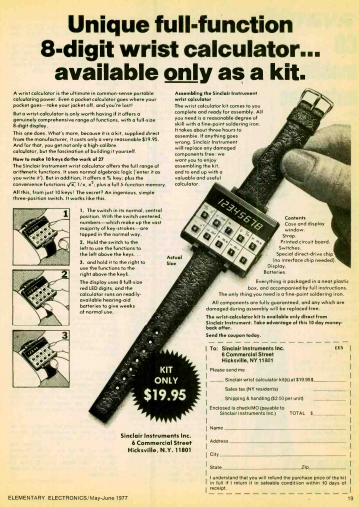 Forty years ago, electronic calculators had been on the market for a few years, and they were starting to get smaller and cheaper. Those who wanted the smallest calculator might have given some consideration to this kit advertised in the May-June 1977 issue of Elementary Electronics.
Forty years ago, electronic calculators had been on the market for a few years, and they were starting to get smaller and cheaper. Those who wanted the smallest calculator might have given some consideration to this kit advertised in the May-June 1977 issue of Elementary Electronics.
Offered by Sinclair (the same people who put out one of the first inexpensive home computers), the wrist calculator sold in kit form for only $19.95. The ad noted that a pocket calculator was good, but goes only where your pocket goes. “Take your jacket off, and you’re lost.”
The wrist calculator, on the other hand, was always with you whenever you had calculating needs.
The calculator featured an eight digit display, and to squeeze in the keyboard, it used ten keys “do the work of 27.” The digits 1-0 were marked on the keys. But on the side of the case was a three position switch. In the center position, the keys entered the numbers. But when set to the left and right, the keys became function keys. In addition to the normal four functions, the calculator boasted percentage, square root, reciprocal, and square. It also had a five-function memory.
A set of readily available hearing aid batteries were said to give weeks of service. All parts were included, and assembly required only a fine-point soldering iron.
